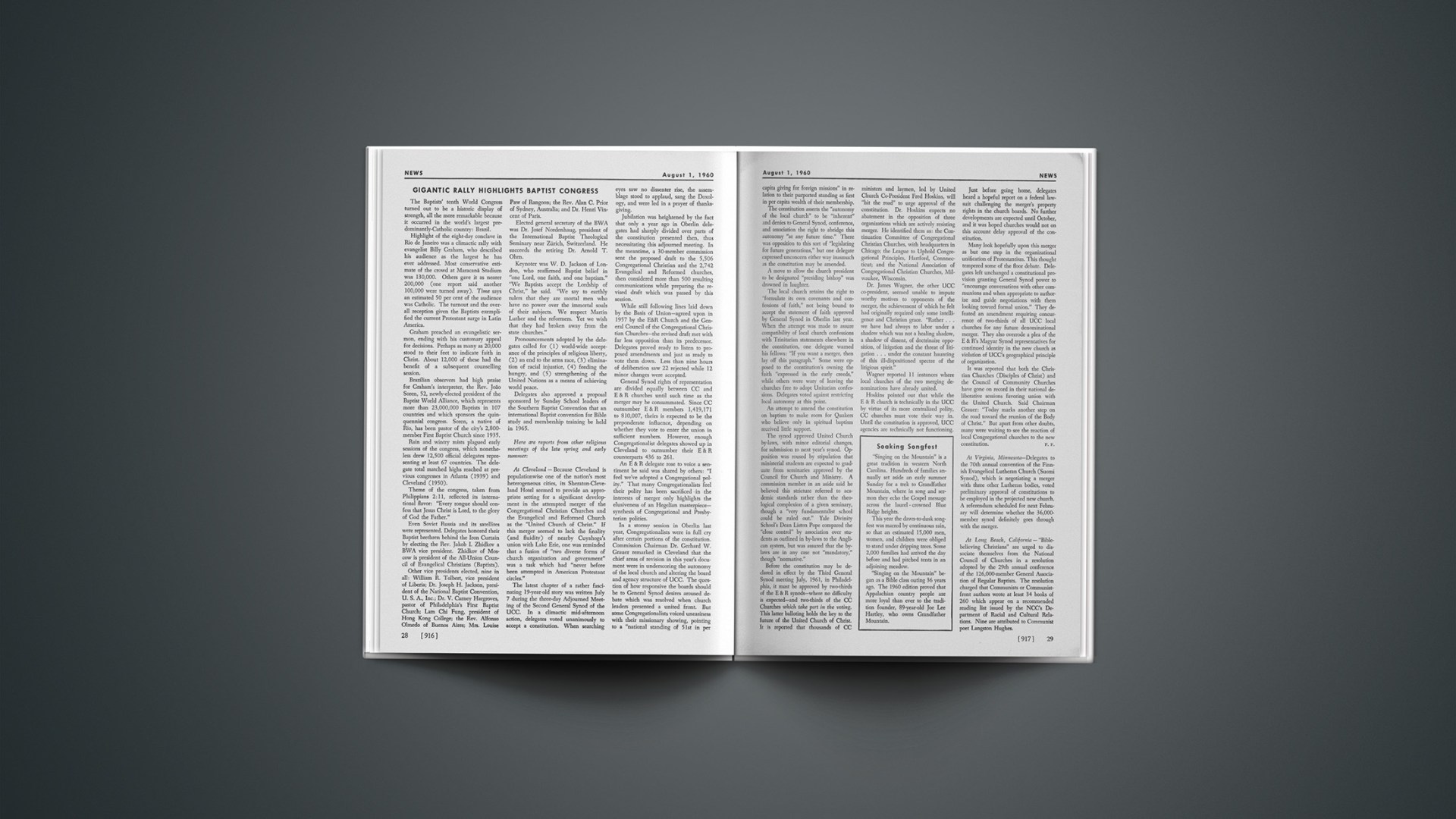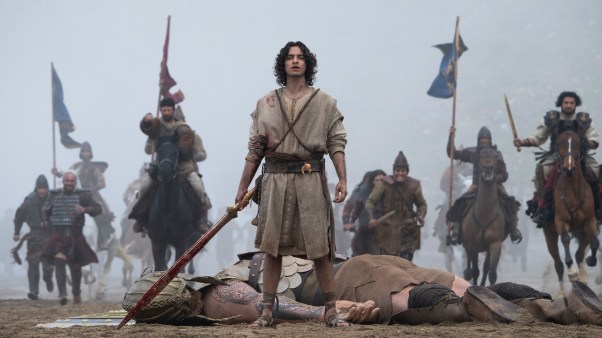The Baptists’ tenth World Congress turned out to be a historic display of strength, all the more remarkable because it occurred in the world’s largest predominantly-Catholic country: Brazil.
Highlight of the eight-day conclave in Rio de Janeiro was a climactic rally with evangelist Billy Graham, who described his audience as the largest he has ever addressed. Most conservative estimate of the crowd at Maracana Stadium was 130,000. Others gave it as nearer (one report said another were turned away). Time says an estimated 50 per cent of the audience was Catholic. The turnout and the overall reception given the Baptists exemplified the current Protestant surge in Latin America.
Graham preached an evangelistic sermon, ending with his customary appeal for decisions. Perhaps as many as 20,000 stood to their feet to indicate faith in Christ. About 12,000 of these had the benefit of a subsequent counselling session.
Brazilian observers had high praise for Graham’s interpreter, the Rev. João Soren, 52, newly-elected president of the Baptist World Alliance, which represents more than 23,000,000 Baptists in 107 countries and which sponsors the quinquennial congress. Soren, a native of Rio, has been pastor of the city’s 2,800-member First Baptist Church since 1935.
Rain and wintry mists plagued early sessions of the congress, which nonetheless drew 12,500 official delegates representing at least 67 countries. The delegate total matched highs reached at previous congresses in Atlanta (1939) and Cleveland (1950).
Theme of the congress, taken from Philippians 2:11, reflected its international flavor: “Every tongue should confess that Jesus Christ is Lord, to the glory of God the Father.”
Even Soviet Russia and its satellites were represented. Delegates honored their Baptist brethren behind the Iron Curtain by electing the Rev. Jakob I. Zhidkov a BWA vice president. Zhidkov of Moscow is president of the All-Union Council of Evangelical Christians (Baptists).
Other vice presidents elected, nine in all: William R. Tolbert, vice president of Liberia; Dr. Joseph H. Jackson, president of the National Baptist Convention, U. S. A., Inc.; Dr. V. Carney Hargroves, pastor of Philadelphia’s First Baptist Church; Lam Chi Fung, president of Hong Kong College; the Rev. Alfonso Olmedo of Buenos Aires; Mrs. Louise Paw of Rangoon; the Rev. Alan C. Prior of Sydney, Australia; and Dr. Henri Vincent of Paris.
Elected general secretary of the BWA was Dr. Josef Nordenhaug, president of the International Baptist Theological Seminary near Zürich, Switzerland. He succeeds the retiring Dr. Arnold T. Ohrn.
Keynoter was W. D. Jackson of London, who reaffirmed Baptist belief in “one Lord, one faith, and one baptism.” “We Baptists accept the Lordship of Christ,” he said. “We say to earthly rulers that they are mortal men who have no power over the immortal souls of their subjects. We respect Martin Luther and the reformers. Yet we wish that they had broken away from the state churches.”
Pronouncements adopted by the delegates called for (1) world-wide acceptance of the principles of religious liberty, (2) an end to the arms race, (3) elimination of racial injustice, (4) feeding the hungry, and (5) strengthening of the United Nations as a means of achieving world peace.
Delegates also approved a proposal sponsored by Sunday School leaders of the Southern Baptist Convention that an international Baptist convention for Bible study and membership training be held in 1965.
Here are reports from other religious meetings of the late spring and early summer:
At Cleveland—Because Cleveland is populationwise one of the nation’s most heterogeneous cities, its Sheraton-Cleveland Hotel seemed to provide an appropriate setting for a significant development in the attempted merger of the Congregational Christian Churches and the Evangelical and Reformed Church as the “United Church of Christ.” If this merger seemed to lack the finality (and fluidity) of nearby Cuyahoga’s union with Lake Erie, one was reminded that a fusion of “two diverse forms of church organization and government” was a task which had “never before been attempted in American Protestant circles.”
The latest chapter of a rather fascinating 19-year-old story was written July 7 during the three-day Adjourned Meeting of the Second General Synod of the UCC. In a climactic mid-afternoon action, delegates voted unanimously to accept a constitution. When searching eyes saw no dissenter rise, the assemblage stood to applaud, sang the Doxology, and were led in a prayer of thanksgiving.
Jubilation was heightened by the fact that only a year ago in Oberlin delegates had sharply divided over parts of the constitution presented then, thus necessitating this adjourned meeting. In the meantime, a 30-member commission sent the proposed draft to the 5,506 Congregational Christian and the 2,742 Evangelical and Reformed churches, then considered more than 500 resulting communications while preparing the revised draft which was passed by this session.
While still following lines laid down by the Basis of Union—agreed upon in 1957 by the E&R Church and the General Council of the Congregational Christian Churches—the revised draft met with far less opposition than its predecessor. Delegates proved ready to listen to proposed amendments and just as ready to vote them down. Less than nine hours of deliberation saw 22 rejected while 12 minor changes were accepted.
General Synod rights of representation are divided equally between CC and E & R churches until such time as the merger may be consummated. Since CC outnumber E&R members 1,419,171 to 810,007, theirs is expected to be the preponderate influence, depending on whether they vote to enter the union in sufficient numbers. However, enough Congregationalist delegates showed up in Cleveland to outnumber their E & R counterparts 436 to 261.
An E & R delegate rose to voice a sentiment he said was shared by others: “I feel we’ve adopted a Congregational polity.” That many Congregationalists feel their polity has been sacrificed in the interests of merger only highlights the elusiveness of an Hegelian masterpiece—synthesis of Congregational and Presbyterian polities.
In a stormy session in Oberlin last year, Congregationalists were in full cry after certain portions of the constitution. Commission Chairman Dr. Gerhard W. Grauer remarked in Cleveland that the chief areas of revision in this year’s document were in underscoring the autonomy of the local church and altering the board and agency structure of UCC. The question of how responsive the boards should be to General Synod desires aroused debate which was resolved when church leaders presented a united front. But some Congregationalists voiced uneasiness with their missionary showing, pointing to a “national standing of 51st in per capita giving for foreign missions” in relation to their purported standing as first in per capita wealth of their membership.
The constitution asserts the “autonomy of the local church” to be “inherent” and denies to General Synod, conference, and association the right to abridge this autonomy “at any future time.” There was opposition to this sort of “legislating for future generations,” but one delegate expressed unconcern either way inasmuch as the constitution may be amended.
A move to allow the church president to be designated “presiding bishop” was drowned in laughter.
The local church retains the right to “formulate its own covenants and confessions of faith,” not being bound to accept the statement of faith approved by General Synod in Oberlin last year. When the attempt was made to assure compatibility of local church confessions with Trinitarian statements elsewhere in the constitution, one delegate warned his fellows: “If you want a merger, then lay off this paragraph.” Some were opposed to the constitution’s owning the faith “expressed in the early creeds,” while others were wary of leaving the churches free to adopt Unitarian confessions. Delegates voted against restricting local autonomy at this point.
An attempt to amend the constitution on baptism to make room for Quakers who believe only in spiritual baptism received little support.
The synod approved United Church by-laws, with minor editorial changes, for submission to next year’s synod. Opposition was roused by stipulation that ministerial students are expected to graduate from seminaries approved by the Council for Church and Ministry. A commission member in an aside said he believed this stricture referred to academic standards rather than the theological complexion of a given seminary, though a “very fundamentalist school could be ruled out.” Yale Divinity School’s Dean Liston Pope compared the “close control” by association over students as outlined in by-laws to the Anglican system, but was assured that the bylaws are in any case not “mandatory,” though “normative.”
Before the constitution may be declared in effect by the Third General Synod meeting July, 1961, in Philadelphia, it must be approved by two-thirds of the E & R synods—where no difficulty is expected—and two-thirds of the CC Churches which take part in the voting. This latter balloting holds the key to the future of the United Church of Christ. It is reported that thousands of CC ministers and laymen, led by United Church Co-President Fred Hoskins, will “hit the road” to urge approval of the constitution. Dr. Hoskins expects no abatement in the opposition of three organizations which are actively resisting merger. He identified them as: the Continuation Committee of Congregational Christian Churches, with headquarters in Chicago; the League to Uphold Congregational Principles, Hartford, Connnecticut; and the National Association of Congregational Christian Churches, Milwaukee, Wisconsin.
Dr. James Wagner, the other UCC co-president, seemed unable to impute worthy motives to opponents of the merger, the achievement of which he felt had originally required only some intelligence and Christian grace. “Rather … we have had always to labor under a shadow which was not a healing shadow, a shadow of dissent, of doctrinaire opposition, of litigation and the threat of litigation … under the constant haunting of this ill-dispositioned spectre of the litigious spirit.”
Wagner reported 11 instances where local churches of the two merging denominations have already united.
Hoskins pointed out that while the E & R church is technically in the UCC by virtue of its more centralized polity, CC churches must vote their way in. Until the constitution is approved, UCC agencies are technically not functioning.
Soaking Songfest
“Singing on the Mountain” is a great tradition in western North Carolina. Hundreds of families annually set aside an early summer Sunday for a trek to Grandfather Mountain, where in song and sermon they echo the Gospel message across the laurel-crowned Blue Ridge heights.
This year the dawn-to-dusk songfest was marred by continuous rain, so that an estimated 15,000 men, women, and children were obliged to stand under dripping trees. Some 2,000 families had arrived the day before and had pitched tents in an adjoining meadow.
“Singing on the Mountain” began as a Bible class outing 36 years ago. The 1960 edition proved that Appalachian country people are more loyal than ever to the tradition founder, 89-year-old Joe Lee Hartley, who owns Grandfather Mountain.
Just before going home, delegates heard a hopeful report on a federal lawsuit challenging the merger’s property rights in the church boards. No further developments are expected until October, and it was hoped churches would not on this account delay approval of the constitution.
Many look hopefully upon this merger as but one step in the organizational unification of Protestantism. This thought tempered some of the floor debate. Delegates left unchanged a constitutional provision granting General Synod power to “encourage conversations with other communions and when appropriate to authorize and guide negotiations with them looking toward formal union.” They defeated an amendment requiring concurrence of two-thirds of all UCC local churches for any future denominational merger. They also overrode a plea of the E & R’s Magyar Synod representatives for continued identity in the new church as violation of UCC’s geographical principle of organization.
It was reported that both the Christian Churches (Disciples of Christ) and the Council of Community Churches have gone on record in their national deliberative sessions favoring union with the United Church. Said Chairman Grauer: “Today marks another step on the road toward the reunion of the Body of Christ.” But apart from other doubts, many were waiting to see the reaction of local Congregational churches to the new constitution.
At Virginia, Minnesota—Delegates to the 70th annual convention of the Finnish Evangelical Lutheran Church (Suomi Synod), which is negotiating a merger with three other Lutheran bodies, voted preliminary approval of constitutions to be employed in the projected new church. A referendum scheduled for next February will determine whether the 36,000-member synod definitely goes through with the merger.
At Long Beach, California—“Bible-believing Christians” are urged to dissociate themselves from the National Council of Churches in a resolution adopted by the 29th annual conference of the 126,000-member General Association of Regular Baptists. The resolution charged that Communists or Communist-front authors wrote at least 34 books of 260 which appear on a recommended reading list issued by the NCC’s Department of Racial and Cultural Relations. Nine are attributed to Communist poet Langston Hughes.
Another resolution, which calls upon the Defense Department to consider a reissue of a controversial Air Force manual, said critics of the text are falsely describing it as a slanderous attack on faithful churches and clergy in general.
Dr. Paul Jackson was named to succeed Dr. R. T. Ketcham as National Representative of the GARB.
At Champaign, Illinois—Plans were unveiled for the relocation of Bethany Biblical Seminary at the 174th annual conference of the Church of the Brethren. The 200,000-member denomination’s only graduate theological school, now located in Chicago, will be moved to a 60-acre site at suburban Lombard, Illinois.
At Cape May, New Jersey—Discussions of economic problems and needs of senior citizens highlighted the biennial meeting of the Religious Society of Friends (General Conference). A number of economists addressed the meeting in connection with round-table discussions.
At Mankato, Minnesota—Strained relations in the Lutheran Synodical Conference of North America was the chief concern of delegates to the annual convention of the Evangelical Lutheran Synod. A special convention in November is to determine whether the synod remains a member of the conference. Many of its ministers are critical of alleged “un-scriptural” practices by the Lutheran Church-Missouri Synod, which also belongs to the conference.
Elmer Gantry
It was cool and comfortable in the theater, and I was short of sleep. The leading character of the movie, posing as a priest, seemed to be deceiving a nun in the dark before the high altar of his church. Two reels later he was framed by a prostitute-with-photographer, and as the picture ended he threw off his robe with the announcement that he was putting away childish things.
A second feature came on, and now the hero was a Communist agitator, the son of a rabbi. He used knockout drops to lead astray his lady commissar boss, and two reels later was framed by a prostitute into giving away atomic secrets. At film’s end he renounced the teachings of Marx-Lenin, saying he had put away childish things.
By this time I knew I was dreaming; after all, Hollywood knows how to avoid sacrilege! So I awoke and found on the screen, thanks to United Artists, a Protestant evangelist betraying a deacon’s daughter and turning her into a prostitute. A couple of reels later she framed him (there is more brothel than church footage in this picture). The camera pans back to the tabernacle to survey the unordained Rev. Mr. Gantry (Burt Lancaster) serially seducing the evangelist-healer (Jean Simmons) and her choir director (Patti Page) with the techniques he learned as a traveling salesman.
Hollywood is quite indignant about this “mockery of Christian beliefs” and unlike author Sinclair Lewis (who wrote the book in 1927) decides such villainy requires judgment. Scripter Richard Brooks (or is it God?) thereby arranges a cigarette butt to burn down the tabernacle and consume the hypocritical tootlers of “Onward Christian Soldiers.” Caught in the blaze with all her cheesecloth is Sister Falconer (Miss Simmons) who receives her divine revelation from shooting stars, and who preaches by rolling her eyeballs, causing children to see the “virgin mother” on the roof.
Virtue, represented by a doddering parson and a doubting-drinking newshawk who dictates his copy at 164 words a minute, triumphs. As for Gantry, he decides that the Bible is the real instigator of all the muck and char, and puts it away with other “childish things.”
Only twice does Mr. Lancaster seem natural: once when brawling with hoboes in a boxcar, again when smashing a small man and pitching him unconscious downstairs. For the rest, he not only acts a phony part, he looks phony acting it. It is not all his fault. While his sermons are delivered with incredible sloppiness, they are scripted by someone who apparently never got inside the flap either of a revival tent or a New Testament.
Technically, much is lacking: the sound track fails to synchronize, dramatic scenes are contrived and unnatural, details are handled with consummate ignorance. More serious, the film is a patent attack on the whole Church of Jesus Christ. As celluloid it is even more unbelievable than the book it distorts, except to those who live where truth is in chains. Moscow will queue up for Elmer, and Ehrenberg’s raves will match the New York critics’.
The Church is not invulnerable. She welcomes social treatment from responsible quarters, and deserves better than a “low blow” purportedly aimed at someone else. Christians are human beings, not dessicated Hollywood corpses who look as if they would sell their souls for gin or orange juice.
S.E.W.
A. H. Ackley
The Rev. Alfred Henry Ackley, a Presbyterian minister who was one of the most noted of contemporary Christian composers, died last month at Whittier, California. He was 73.
Ackley was best known for Gospel songs such as “He Lives,” “Heartaches,” “God’s Tomorrow,” “Song of the Soul Set Free,” and “At the End of the Road.” He had teamed with his late brother, B. D. Ackley, in more than 5,000 compositions.
Once associated with evangelist Billy Sunday, A. H. Ackley had more recently been writing for the Rodeheaver-Hall Mack Company, publishers of church music. He is survived by his wife and two sons.
‘This Is Death’
Mrs. Helen Frazee-Bower, Christian poet, died at Campbellsville, Kentucky, June 25.
A prolific writer for many years, Mrs. Frazee-Bower more recently devoted herself to penning words for hymns and Gospel songs. She developed 38 such selections in the last two years of her life, nine of which have already been set to music by her composer husband, William M. Bower, formerly of the Los Angeles symphony and philharmonic orchestras.
Several of Mrs. Frazee-Bower’s poems have already appeared in CHRISTIANITY TODAY. The following, hitherto unpublished, was one of her last:
THIS IS DEATH
This is not death, but triumph and reward:
To walk by faith through all life’s little day
And then, at eventide, to meet the Lord
And hand in hand with Him to go away.
This is not death—this is abundant life,
Eternal life, the freeing of the soul
For bliss beyond earth’s time of toil and strife.
This is not death, but the immortal goal.
But this is death: In trespasses and sin
All through life’s journey carelessly to roam;
To find the Door—and never enter in;
To see the Truth—and never take it home.
Unmindful of the Christ, to draw each breath
As though this world were final. This is death.
People: Words And Events
Deaths:Dr. Thomas J. McCrossan, 95, retired Presbyterian minister; in Los Angeles … Dr. Benjamin L. Olmstead, editor of Free Methodist Sunday School literature; in Chicago.
Retirement: From the presidency of Messiah College, Dr. C. N. Hostetter, Jr.
Elections: As bishops of The Methodist Church (North Central Jurisdiction), Dr. T. Otto Nall, editor of the Christian Advocate; Dr. Ralph T. Alton, pastor of the First Methodist Church in Appleton, Wisconsin; and Dr. Edwin R. Garrison, church headquarters administrator in Indiana … as president of the Lutheran Laymen’s League, Harry G. Barr … as moderator of the Church of the Brethren, Dr. Charles E. Zunkel … as moderator of the Reformed Presbyterian Church in North America, Dr. Richard W. Gray.
Appointments: As acting administrative officer at Northern Baptist Theological Seminary, Dr. Benjamin P. Browne … as executive secretary of the United Presbyterian Department of Chaplains and Service Personnel, Navy Chaplain (Captain) Harry C. Wood … as president of Taejon (Korea) College, the Rev. John E. Talmage, succeeding Dr. William Linton, founder and first president of the Southern Presbyterian mission school, who now retires from the mission field after 48 years of Korean service … as United Presbyterian commission representative in Korea, Dr. Samuel Hugh Moffett … as head of the department of Christian education at Manhattan Bible College, Dr. Charles R. Gresham; as professor of humanities and missions, Dr. James G. Van Buren.
Awards: To the four chaplains of the sunken U.S.S. Dorchester, known for one of the most heroic acts of World War II (forcing their life jackets upon men without them), specially-designed Congressional Medals of Honor.










